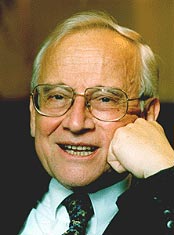

Rudolf Zahradník

Born October 20, 1928 in Bratislava, former Czechoslovakia.
President, Academy of Sciences of the Czech Republic. Professor of Physical Chemistry, Charles University, Prague, Czech Republic.
Member of the Academy of Quantum Molecular Sciences (1982), Fellow of WATOC (1986), Honorary Membership of the Chemical Society, GDR, (1987), Honorary Membership of the Swiss Chemical Society (1988), member of the European Academy of Arts, Sciences and Literature (Paris, 1992), member of the European Academy of Environmental Affairs (1994), corresponding member of the Croatian Academy of Sciences and Arts (1994), member of the Engineering Academy of the Czech Republic, Prague (1995), member of European Academy of Sciences and Arts (Salzburg, 1997), member of GDch (1999), member of Academia Europeae (U.K., 2000), Honorary Degrees (Dr.h.c.): TU Dresden (1993), Univ. of Fribourg (1993), TU Pardubice (1994), Georgetown University, Washington, D.C. (1996), Charles University, Prague (1998), Clarkson University, Potsdam (1998), Comenius University, Bratislava (2000), President, the Czech Learned Society (1994–1997, currently member).
Awards: Medal of Slovak Institute of Technology (1989), J. Heyrovsky Gold Medal of the Czechoslovak Academy of Sciences (1990), Gold Medal (Chemistry) of the Slovak Academy of Sciences, Bratislava (1994), Gold Medal of Charles University, Prague (1995), Austrian 1st Class Honorary Cross for Science and Arts (1999).
Author of:
Important Contributions:
An obituary can be found here.